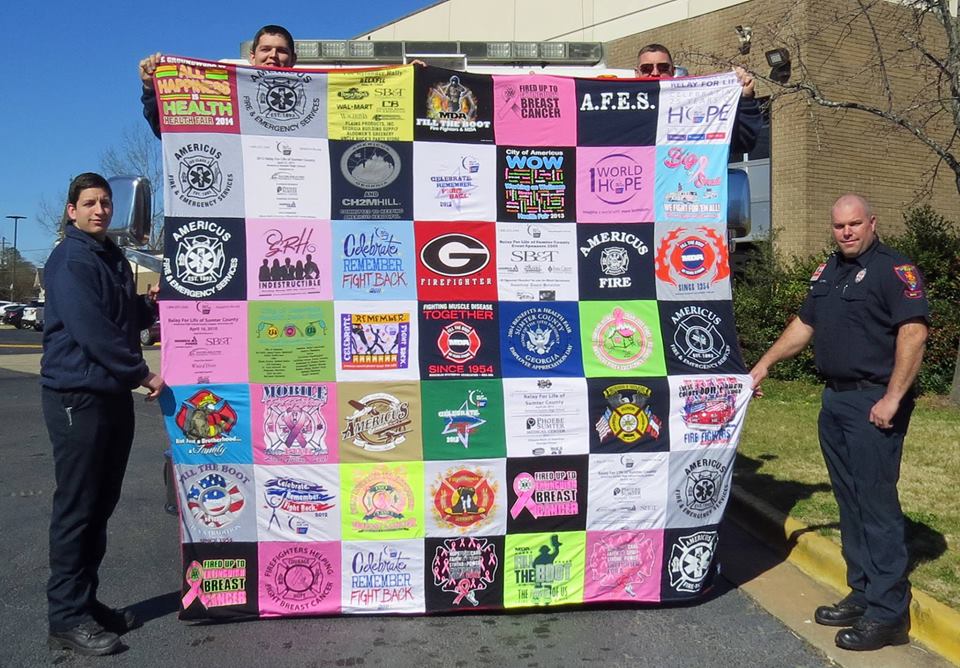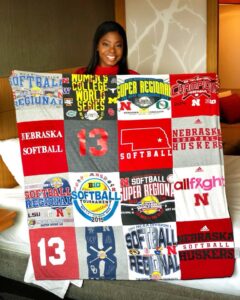
Workers in Massachusetts and North Carolina transform T-shirts into treasures.
Boston area natives Nathan Rothstein and Ross Lohr became fast friends in 2010 while studying for their MBA degrees at Brandeis University. The business school classmates caught the entrepreneurial bug and decided to collaborate on a business venture together.

Lohr had spent some time doing non-profit education work in Kenya and was amazed at the number of T-shirts being sold in secondary markets in East Africa. They both were knee deep in T-shirts of their own and began thinking about how many shirts people across the world had in their closets that eventually reached the secondary markets of poor countries, were thrown away or kept in drawers and boxes because of the sentimental value to their owners.
After unsuccessful attempts to repurpose old T-shirts by making products such as tote bags and scarves, the duo came up with the idea to make quilts by sewing together the designs on the shirts and backing them with fleece.
Upcycling T-shirts into American jobs, they call it.
In February 2012, Rothstein and Lohr officially launched Project Repat, allowing customers to send in their old T-shirts to be transformed into quilts. While the old shirts were produced all over the world, the upcycled blankets are strictly created in the United States.
“Repat is short for repatriating textile jobs back to the U.S.,” Rothstein said. “A lot of the shirts are made overseas so by turning them into T-shirt quilts here, we are bringing those textile jobs back.
“The average American throws out about 70 pounds of textile waste a year, much of which ends up in a landfill. What’s nice about it is it preserves those T-shirts memories, it keeps them out of landfills, and it turns all those T-shirts that were made overseas into U.S. jobs.”

Project Repat quilts are manufactured by Precision Sportswear in Fall River, Mass. and Opportunity Threads in Valdese, N.C. These production partners have become a perfect fit for Project Repat because at one time these companies’ respective states had thriving textile industries with a skilled labor pool able to produce thousands of quilts each week.
And business is booming. Rothstein and Lohr began selling the quilts in 2012 and grossed about $250,000 during Project Repat’s first year in business, helped along by outreach via Groupon and LivingSocial, which were big at the time.
Rothstein and Lohr expect to have gross sales of nearly $10 million this year.
In 2017, they sold approximately 65,000 quilts and prevented more than 1.2 million shirts from rotting in America’s landfills. Since Project Repat’s inception, Rothstein estimates the company has repurposed approximately 5 million T-shirts. The partners expect to sell more than 100,000 quilts in 2018.
The quilt manufacturers, Precision Sportswear and Opportunity Threads, employ 60 to 70 cut and sew workers to manufacture the Project Repat quilts. They also provide the shipping, distribution and warehousing. Rothstein and Lohr and a small Project Repat staff handle the marketing, sales and logistics.
“We are making 2,000 quilts a week right now in the summer, and that will go up to about 3,000 during the holiday season,” Rothstein said. “We feel strongly about people making a fair wage to make our stuff and I think that’s what Made in America means. People aren’t making 50 cents an hour to make something like they might be in China or other countries. That’s important to us.
“We are committed to making things here in the U.S.”
Making the Quilts
Project Repat quilts are made from panels – generally 12 x 12 inches – of the imprinted T-shirts. A die-cutter press is used to create the exact size of each panel, which are then sewn together. Fleece is then sewn around the edges, making the completed product a display of the customer’s worn apparel with a soft Polartec fleece backing.
Customers are asked to separate the front from the back of the T-shirts, because both sides of the shirts can be used if requested. Project Repat sends potential customers prep instructions with an order confirmation to make sure there is no confusion about the correct panels that make up the quilt.
“Our team will design it, we’ll spread it around or some people will send us a photo of the way they want it designed,” Rothstein said. “Turnaround time right now is four to five weeks.”
After customers gather their memorable T-shirts, or other apparel items, they send them to Project Repat, indicating the size of the quilt requested. The more shirts submitted, the larger the quilt. For example, the lap quilt requires 16 shirt panels, while the largest, king-sized quilt requires 64 shirt panels.
The fleece backing on the quilts is made of Polartec fabric and comes in a variety of colors. Polartec has become well-known for its use of billions of discarded plastic water bottles when making the yarn for its fleece fabrics. But Project Repat will also be sourcing fleece from JoAnn’s Fabrics in the near future because these industry-leading fleece makers are increasingly sending their production offshore.
“The average American throws out about 70 pounds of textile waste a year, much of which ends up in a landfill. What’s nice about it is it preserves those T-shirts memories, it keeps them out of landfills, and it turns all those T-shirts that were made overseas into U.S. jobs.” Nathan Rothstein, Project Repat
Unlike other quilt-making companies that create products primarily for display purposes, Project Repat quilts are meant to be used.
“It stays together well, and it’s easily washed and holds up well,” Rothstein said. “It stands the test of time. It’s meant to be used. I think people like using it around the couch or they use it for their bed. It’s not a museum-type piece or for hanging on the wall. It’s for your everyday use.”
The bulk of Project Repat’s orders are for quilts comprised of old T-shirts. But a useable quilt can also be made with jerseys, sweat shirts, flannel and other clothing items.
“Football jerseys are great,” Rothstein said. “We’ve seen some great blankets from people who just kept jerseys around for 30 or 40 years.”
Quite often there is a theme to the collection of shirts that make up the quilts, but customers are free to design whatever they want to showcase. Popular quilts may be comprised of a customer’s favorite sports team’s shirts or their collection of concert shirts.
“It is a lot of moms buying it as graduation gifts for their kids so it’s a lot of sports shirts or whatever activity they were part of,” Rothstein said. “Shirts from camps, musicians and it’s a big one for a lot of Greek life, like all of your fraternity or sorority T-shirts.
“For runners you get a shirt for every race you run, and it has also turned into a way to memorialize someone that has passed away.”
Whether a Project Repat quilt has a specific theme or is just a hodge-podge of a customer’s favorite garments, the comfortable blankets are all about memories.
And the purchase price of the quilts adds another layer of comfort. The smallest quilt, which measures at 4 x 4 feet, utilizes 16 shirt panels and sells for $75. The top of the line 8 x 8 feet quilt requires 64 panels and is available for $250. The most popular quilt, easily used on the couch or a college dorm room bed at 5 x 6 feet, is comprised of 30 panels and is available for $130.
A Project Repat quilt is environmentally friendly, unique, affordable, creates jobs and is stitched full of precious memories. And best of all, it’s Made in America.
